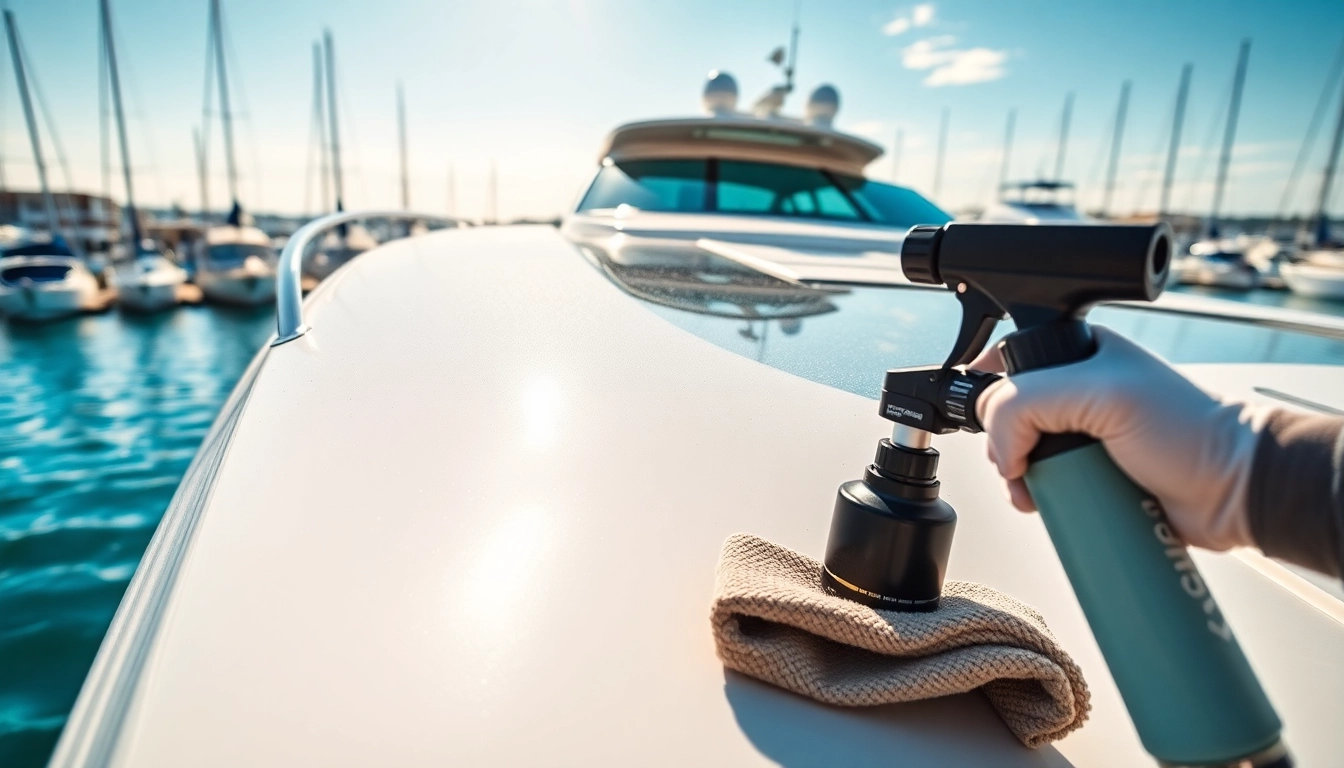Understanding Marine Ceramic Coating
What is Marine Ceramic Coating?
Marine ceramic coating is a high-performance protective solution specifically formulated for marine applications. This advanced coating creates a durable layer of protection on boat surfaces, primarily enhancing the longevity of fiberglass, gel coat, and painted finishes. Unlike traditional waxes and sealants, which wear off after a few weeks or months, Marine Ceramic Coating forms a semi-permanent bond with the surface, offering long-lasting protection against various environmental factors.
How Does Marine Ceramic Coating Work?
The science behind marine ceramic coating lies in its chemical composition. Typically composed of silica dioxide (SiO2), this coating forms a hard, protective shell on the surface of your vessel. When applied, the coating undergoes a curing process, transforming into a hydrophobic layer that repels water, dirt, grime, and other contaminants. This hydrophobic effect causes water to bead and roll off the surface, effectively reducing the accumulation of marine growth and making routine cleaning much easier.
Key Ingredients in Marine Ceramic Coating
Marine ceramic coatings are rich in advanced polymers and silica. The primary ingredient, silica dioxide, is crucial for the coating’s strength and durability. Moreover, some formulations include additional components like titanium dioxide or other hydrophobic agents to enhance the coating’s protective and aesthetic properties. The synergistic effect of these ingredients ensures that the marine ceramic coating can withstand harsh saltwater environments and UV exposure, significantly extending the lifespan of the surfaces it protects.
Benefits of Using Marine Ceramic Coating
Long-term Protection Against UV Damage
One of the most significant advantages of marine ceramic coatings is their ability to provide long-term UV protection. The relentless exposure to the sun can cause oxidation and fading on boat surfaces. Marine ceramic coatings create a barrier that reflects harmful UV rays, thereby preventing degradation and discoloration of the underlying material. Consequently, boats treated with this coating maintain their aesthetic appeal much longer compared to those protected by traditional wax.
Enhanced Aesthetics and Shine
In addition to protection, marine ceramic coatings enhance the aesthetic appeal of your vessel. The application of a ceramic coating results in a deep, glossy finish that not only looks new but also improves the overall allure of the boat. This shine is not just surface level; it penetrates and improves the clarity of painted and gel coat finishes, making your boat stand out in the water.
Resistance to Environmental Contaminants
The marine environment is rife with contaminants such as salt, dirt, barnacles, and algae that can damage boat surfaces. Marine ceramic coatings act as a formidable defense against these elements. The hydrophobic properties allow contaminants to be easily rinsed away with water, minimizing the risk of stains and buildup. This enhanced resistance helps in maintaining the boat’s appearance and reduces the need for frequent cleaning.
Applying Marine Ceramic Coating
Preparation Steps for the Surface
Proper surface preparation is critical for achieving the best results when applying marine ceramic coating. Start by thoroughly cleaning the surface using a high-quality boat wash. This helps remove any dirt, grime, or wax residues. Next, inspect the surface for imperfections such as scratches, abrasions, or oxidation. Depending on the condition of your boat, you may need to polish the surface to create a smooth base for the ceramic coating.
Application Techniques for Marine Ceramic Coating
After preparing the surface, the application process can begin. It is crucial to follow the manufacturer’s instructions for the specific product you are using. Generally, the application involves using a foam applicator or microfiber cloth to apply the coating in a section-by-section manner. It’s recommended to apply the coating in thin, even layers, ensuring complete coverage. Ideally, allow the coating to cure for the time specified on the product label before exposing it to water.
Post-Application Maintenance
Once the marine ceramic coating is applied and cured, upkeep becomes essential to maintain its protective qualities. Regular washing with a pH-balanced boat soap will help remove contaminants without degrading the coating. Additionally, using a maintenance spray formulated for ceramic coatings after washing can further enhance the hydrophobic properties and shine of your boat, prolonging the coating’s effectiveness.
Marine Ceramic Coating vs. Traditional Waxing
Durability Comparison
When comparing marine ceramic coatings to traditional waxing, the differences in durability are stark. A standard wax job may last anywhere from one to three months, requiring frequent reapplication, especially in harsh marine settings. Conversely, marine ceramic coatings can last several years when properly maintained, offering a much more robust and long-lasting solution for boat protection.
Cost-Effectiveness Over Time
While the upfront cost of applying marine ceramic coating may be higher than traditional wax, the long-term savings are evident. With less frequent applications and reduced need for cleaning and detailing, boat owners can save money over time. Moreover, the increased resale value of a well-maintained boat protected by ceramic coatings can be significant, making it a wise investment.
Ease of Application
The application process for ceramic coatings can be more technical compared to traditional waxing, which is typically straightforward and doesn’t usually require extensive training or expertise. However, with adequate research and following the correct procedure, individuals can apply marine ceramic coatings themselves or hire professional services for optimal results.
Choosing the Right Marine Ceramic Coating
Factors to Consider Before Purchase
When selecting a marine ceramic coating, several factors should be considered. Assessing the composition of the product, its durability claims, and warranty details can aid in making an informed choice. Additionally, understanding your boat’s specific needs based on the environment it operates in will help in selecting a product that offers optimal protection.
Top Features to Look For
High-quality marine ceramic coatings will often highlight several critical features, including hydrophobic properties, UV resistance, and ease of application. Look for products that specify the percentage of SiO2 content, as a higher concentration typically indicates better performance. Other functionalities, such as scratch resistance and self-cleaning properties, can further enhance the protection afforded to your boat.
Advice from Industry Experts
Before making a final purchase decision, it’s advisable to consult with industry experts or peer boat owners who have experience in applying and maintaining marine ceramic coatings. Online forums and product reviews can provide valuable insights into user experiences, as well as practical tips for maximizing the effectiveness of the coating and maintenance techniques post-application.



